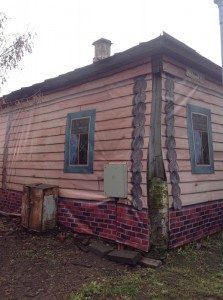There’s a story that when Catherine the Great’s one-time lover Prince Grigory Aleksandrovich Potemkin wanted to show his monarch the glories of her not-yet-so-glorious lands in Ukraine, he built façades along the tour route and populated the path with jolly, well-dressed peasants. These “Potemkin villages” were torn down each night and reconstructed along the next portion of the tour route, in this case the Dneiper River, so that everything the queen and her entourage saw looked pleasant and prosperous.
Your seams are showing: Two facades don’t quite meet perfectly at the corner of this dwelling.

This is a story, not an established fact. While sprucing up the outskirts of the kingdom almost certainly did occur before Catherine’s trip, modern historians argue that the wholesale fakery of legend is itself not true. But since beauty is, after all, truth, this tale’s lovely summation of hubris, ambition, and obsequiousness in one believable package has made it a standard tale to explain Imperial Russia (and beyond).
Modern Russia, meanwhile, seems beset with a pox of Potemkins—Potemkin capitalism, Potemkin democracy, Potemkin modernization. These coinages all aim to deflate the puffery of Vladimir Putin’s Russia. The subtext is that Putin himself is a sort of imperial reincarnation, a widely discussed idea that I suspect is in no way insulting to Putin or many modern Russians. As Nina Khrushcheva opined in The Moscow Times—in a piece titled “The Imperial Putin”—“The sad truth is that in Russia history does indeed repeat itself — but in a twist on Karl Marx’s dictum, as tragedy and farce at once.”
And so we come to the modern Potemkin villages, born this time not in fable but fact. As Russian media (h/t BBC News) has reported, after apparent prompting from acting Governor Svetlana Orlova, authorities in Suzdal laid painted tarps over the city’s more decrepit structures to make them presentable before a conference welcomed a tide of local government administrators and its guest of honor, Putin. Suzdal is a historic place—it even made the UNESCO World Heritage List—so a little decrepitude in the name of atmosphere might pass muster, but widespread blight is another matter.
Among the static scenes presented on the Suzdal facades was a resting cat.

The banners included painted siding, birch trees, clean and unbroken windows, green plants on the ledges, even a cat. In a post loaded with photos, blogger Natalia Novozhilova asked (thank Google Translate for the Yakov Smirnoff-y phrasing): “Why is not depicted in the windows of happy faces Suzdal?” One reason for the lack of happy faces is that the “king,” as she snarkily termed Putin (another blog used the word “emperor”), did not deign to make his expected November 8 appearance at the conference.
His majesty did not request the Orlova villages, just as her majesty before didn’t request the Potemkin variety. English-language RIA Novosti quoted a regional official who said Suzdal officials couldn’t do more than drape the buildings because they couldn’t find the absentee owners on short notice. Besides, she added, probably with a patriotic edge, Leningrad put up façades on burned-out buildings during its heroic 900-day siege by the Nazis. Talk about wrapping yourself in the flag.
The desire to put a best face forward to dignitaries—even if that face is a mask—isn’t in any way unique to Russia. Folks in Northern Ireland’s County Fermanagh had their knickers in a knot over very similar, if even more professional, banners—at a reported £300,000 they better be nicer—that upgraded derelict shops before this June’s G8 summit. (Putin attended that meeting. Just sayin’.) The United States kicked out our ruling monarchs centuries ago, and so here the Potemkin impulse is more egalitarian: in a few blighted areas, cheerful façades, both plastic and applique, have replaced plywood on vacant buildings. “If you’re just driving by, just trying to get a feel for the neighborhood, you probably won’t notice,” explained Wall Street Journal reporter Conor Dougherty in a classic explanation of the Potemkin effect.
Russia, nonetheless, has a Potemkin problem. At Global Voices Online, blogger Daniil Tereschenko’s account of Prime Minister Dmitry Medvedev’s visit to a Potemkin-ized hospital was followed by commenters recounting similar stories from universities, factories, and even a frozen fountain. “It was the same when he visited the [Moscow State University] Journalism School,” wrote “salome_lou.” “I didn’t recognize our main lecture hall, it was redone down to the carpeting, and later everything was taken away.”
But since beauty is truth, perhaps these over-eager bureaucratic aestheticians could call these cover-ups “art.” It works for Christo….



